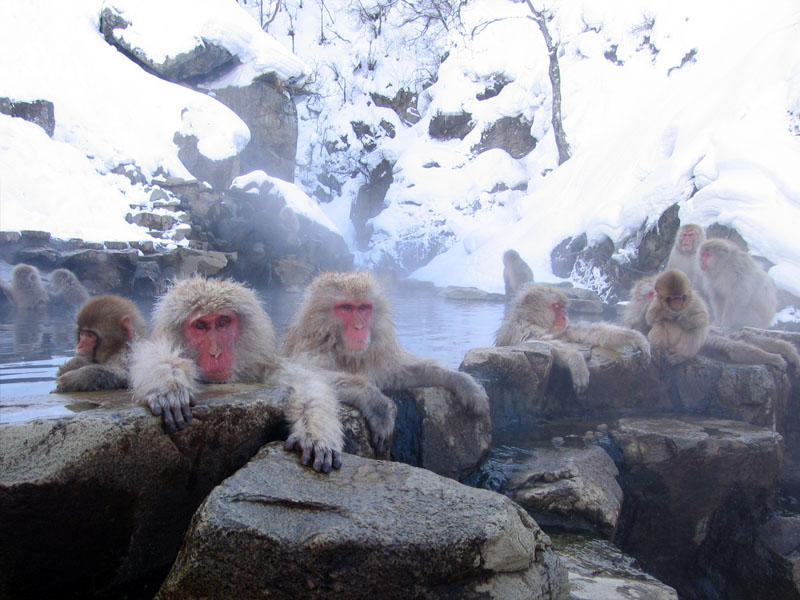|
| 질의: Mammal | 결과: 2504번째/3457 | |
Japanese Macaque / Snow Monkey (Macaca fuscata) - Wiki
| 제목: | Japanese Macaque / Snow Monkey (Macaca fuscata) - Wiki
| |

| 해상도: 800x600
파일크기: 133586 Bytes
촬영일: 2005:02:11 10:52:59
사진기: Canon PowerShot S60 (Canon)
F number: f/5.6
Exposure: 1/80 sec
Focal Length: 186/32
등록시간: 2006:12:10 13:47:27
|
Japanese Macaque
From Wikipedia, the free encyclopedia
[Photo] Japanese Macaques (Macaca fuscata). Jigokudani Hot Spring in Nagano Prefecture, Japan. It is famous that monkeys take a bath. Photo by Yosemite 11:21, 14 Feb 2005 (UTC). http://commons.wikimedia.org/wiki/User:Yosemite
The Japanese Macaque (Macaca fuscata), also known as the Snow Monkey, is a terrestrial Old World monkey species native to northern Japan, although an introduced free-ranging population has been living near Laredo, Texas since 1972. It is the most northern-living non-human primate. Individuals have brown-gray fur, a red face, hands and bottom, and a short tail. There are two subspecies of this macaque:
- Macaca fuscata fuscata
- Yakushima Macaque, Macaca fuscata yakui
Range and diet
The Japanese Macaque is diurnal and spends most of its time in forests. It lives in a variety of forest-types, including subtropical to subalpine, deciduous, broadleaf and evergreen forests, below 1500 m. It feeds on seeds, roots, buds, fruit, invertebrates, berries, leaves, birds eggs, fungi, bark and cereals. It has a body length ranging from 79 to 95 cm, with a tail length of approximately 10 cm. Males weigh from 10 to 14 kg, females, around 5.5 kg.
The Japanese Macaque is the most northerly-living non-human primate, living in mountainous areas of Honsh??, Japan. It survives winter temperatures below -15 °C (5° F), and is perhaps most famous for the amount of time it spends relaxing in naturally heated volcanic hot springs.
Social organization and reproduction
The Japanese Macaque lives in troops 20-100 individuals in size usually subdivided into matrilineal groups consisting of many females and several males. On average, females outnumber males by 3 to 1. The females have a rigid hierarchy with infants inheriting their mother's rank. The males tend to be transient within the troop.
Females will copulate with an average of ten males during the mating season, though only about one third of the mountings will lead to ejaculation. Though pregnancies only occur during the mating season, heterosexual relations go on year-round. After a gestation period of 173 days, females bear only one baby, which weighs about 500 g at birth. This macaque has an average lifespan of 30 years.
Same-sex relations are frequent, rates however vary between troops. Females will form consortships characterized by affectionate, social and sexual activities. In some troops up to one quarter of the females will form such bonds, which will vary in duration from a few days to a few weeks. Often, strong and lasting friendships will result from such pairings. Males also have same-sex relations, typically with multiple partners of the same age. Affectionate and playful activities are associated with such relations.[3]
Other aspects
The Japanese Macaque is very smart. It is the only animal other than humans and raccoons that is known to wash its food before eating it. Researchers studying this species left sweet potatoes out on the beach for them to feed on, then witnessed one female taking the food down to the sea to wash the sand off it. After a while, others started to copy her behavior. This trait was then passed on from generation to generation, until eventually, all except the very oldest members of the troop were washing their food in the sea. A somewhat altered account of this incident was the basis for the "Hundredth Monkey" meme.
Also in recent studies, it has been found that the Japanese Macaque can develop different accents, like humans. It was found that macaques in areas separated by only a couple hundred miles can have very different pitches in their calls, their form of communication. The Japanese Macaque has been involved in many studies concerning neuroscience and also is used in drug testing. [1]
It is often the subject of Buddhist myths, and is thought to be the inspiration behind the saying "see no evil, hear no evil, speak no evil."
The Japanese Macaque is classified as Data Deficient by the 2000 IUCN Red List.[2]
References
^ a b Groves, Colin (16 November 2005). Wilson, D. E., and Reeder, D. M. (eds): Mammal Species of the World, 3rd edition, Johns Hopkins University Press, 162. ISBN 0-801-88221-4.
^ a b Eudey, A. & Members of the Primate Specialist Group (2000). Macaca fuscata. 2006 IUCN Red List of Threatened Species. IUCN 2006. Retrieved on {{{downloaded}}}. Database entry includes a brief justification of why this species is listed as data deficient
^ Bruce Bagemihl, Biological Exuberance: Animal Homosexuality and Natural Diversity, St. Martin's Press, 1999; pp.302-305
Macaca fuscata (TSN 555659). Integrated Taxonomic Information System. Accessed on 23 March 2006.
http://en.wikipedia.org/wiki/Japanese_Macaque
| The text in this page is based on the copyrighted Wikipedia article shown in above URL. It is used under the GNU Free Documentation License. You may redistribute it, verbatim or modified, providing that you comply with the terms of the GFDL. |
|
^o^
동물그림창고 똑똑전화 누리집
^o^
|
|

